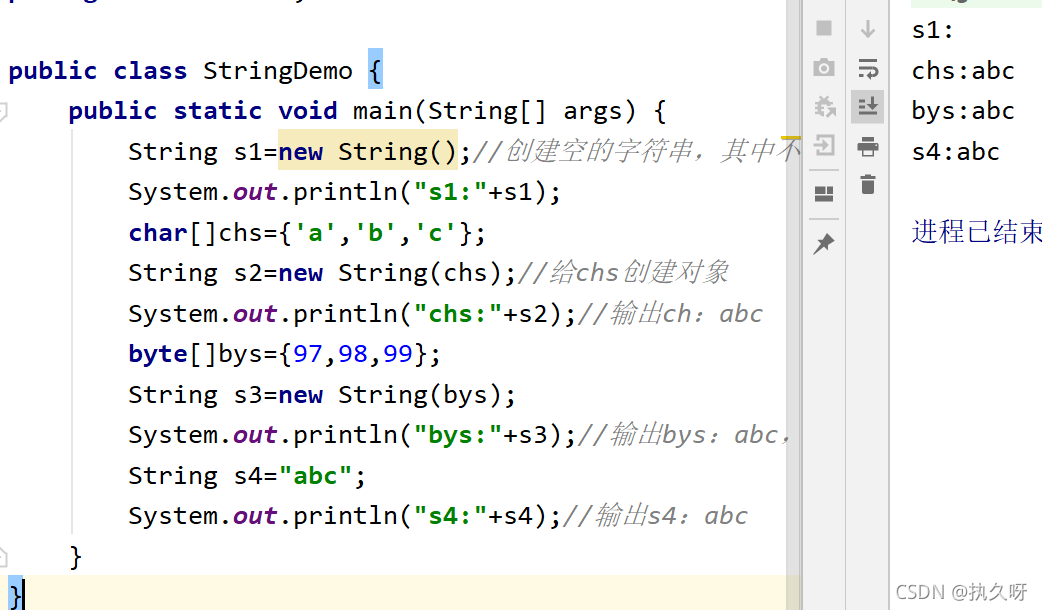目录
一、前言
在java中,和C语言一样,也有关于字符串的定义,并且有他自己特有的功能,下面我们
一起来学习一下。
二、String类概述
string在软件包java.lang下,所以不需要导包。
String字符串是java中的重点,String 类表示字符串类 ,所有的字符串(如"adf")都属于
此类,也就是说有" "双引号括起来的都属于此类,
三、字符串的特点
字符串不可变,他们的值在创建之后不能被改变。
虽然String的值的不可变的,但是他们可以被共享。共享就是其他成员也可以拥有这个值,
字符串效果相当于数组(char[]),但是底层原理是字节数组(byte[])
jdk8以前是字符数组,jdk9以后是字节数组。
四、String 构造方法
public String()? //创建一个空白字符串对象,不含有任何内容。
public String(char[] ch)//根据字符数组的内容来创建字符对象。
public String (byte[] b)//根据字节数组的内容来创建字节对象。
String s=“abc”? ? ? ? ?//字节赋值的方式创建对象,内容就是abc。
图示:?

代码演示:
public class StringDemo {
public static void main(String[] args) {
String s1=new String();//创建空的字符串,其中不包括任何内容
System.out.println("s1:"+s1);
char[]chs={'a','b','c'};
String s2=new String(chs);//给chs创建对象
System.out.println("chs:"+s2);//输出ch:abc
byte[]bys={97,98,99};
String s3=new String(bys);
System.out.println("bys:"+s3);//输出bys:abc,他会 转化成对应的Ascll码值
String s4="abc";
System.out.println("s4:"+s4);//输出s4:abc
}
}
综上看,推荐使用直接赋值的方式得到字符串对象。
五、String类对象的特点
通过new创建的的字符串对象,每一次new都会申请一个内存空间,虽然内容一样,
但是地址不同
通过直接赋值的方式来创建对象,赋值相同的值,因为是常量在堆内存的常量池中,
进入常量池的规则是:如果常量池中没有这个常量,则在常量池中创建一个,如果有
,则把已经存在的常量地址赋值给他,所以创建不同的变量去接受相同的值,他的内容
是一样的,地址也是一样的 。
六、比较字符串的方法
我们在比较两个数字是否相同时,一般用的是==来判断,那么要比较两个字符串相等
用的是什么呢,答案是用equls。
==用来判断两个字符串的地址是否相同,相同返回true,不同返回false。
equls用来比较两个字符串的值是否相同,相同返回true,不同返回false。
用法:
public class String1 {
public static void main(String[] args) {
String s1="hello";
String s2="world";
String s3= "helloworld";
String s4=s1+s2;
System.out.println(s7==s8);//0
System.out.println(s3==s4);//比较两个字符串的地址是否相同
System.out.println(s3.equals(s4));//比较两个字符串中的值是否相同
}
}代码图示:

?原因下文分析。
七、判断两个字符串地址是否相等
在字符串中,两个字符串相加可以的到一个新的字符串,这是我们知道的,但是地址会是一样的吗
看下列代码:
public class String1 {
public static void main(String[] args) {
String s1="hello";
String s2="world";
String s3= "helloworld";
String s4=s1+s2;
String s5="he"+"llo";
String s6="hello"+"world";
String s7="hello"+s2;
String s8=s1+"world";
System.out.println(s3==s6);//比较两个地址是否相同
System.out.println(s1==s5);
System.out.println(s3==s7);
System.out.println(s3==s8);
System.out.println(s7==s8);
System.out.println(s3==s4);
System.out.println(s3.equals(s4));//比较两个字符串中的值是否相同
}
}
我们仔细分析:
第一个:
String s3= "helloworld";
String s6="hello"+"world";s3首先在常量池中创建了一个helloworld的常量,s6是有两个新的字符串连接起来的,
这两个字符串常量创建新的字符串常量,存储在常量池中时,因为helloworld已经存在,
所以常量池就不会创建新的字符串了,直接把已经存在的s3地址赋值给s6,所以他们地址
相同。
第二个:
String s1="hello";
String s5="he"+"llo";这个分析和第一个一样,地址相同。
第三个:
String s2="world";
String s3= "helloworld";
String s7="hello"+s2;s2在常量池中创建world,s3在常量池中创建helloworld,s7是由一个变量s2连接一
个新的字符串"world",首先会在常量池创建字符串"world",然后两者之间进行"+"
操作,根据字符串的串联规则,s7会在堆内存中创建StringBuilder(或StringBuffer)
对象,通过append方法拼接s2和字符串常量"world”,此时拼接成的字符串"helloworld"
是StringBuilder(或StringBuffer)类型的对象,通过调用toString方法转成String对
象"helloworld",所以s7此时实际指向的是堆内存中的"helloworld"对象,堆内存中对
象的地址和常量池中对象的地址不一样。
StringBuilder和StringBuffer的区别
1.StringBuffer 对几乎所有的方法都实现了同步,线程比较安全,在多线程系统中可以保
证数据同步。
2.StringBuilder 没有实现同步,线程不安全,在多线程系统中不能使用 StringBuilder。
3.当需要考虑线程安全的场景下使用 StringBuffer,如果不需要考虑线程安全,追求效率的场
景下可以使用 StringBuilder。
第四个:
String s1="hello";
String s3= "helloworld";
String s8=s1+"world";解释同上,重新简单的说一下,s3在先在常量池中创建helloworld,s8是由变量s1和常量
world加起来的,会先在常量池中创建world,然他他们现在之后会在堆内存中存在,所以
他们的地址不同。

?总结:一般带有变量的相加操作是在堆中创建的
?第五个:
String s1="hello";
String s2="world";
String s7="hello"+s2;
String s8=s1+"world";解释和上面有些相似之处,他们都是有变量加常量,所以他们都是在堆内存中创建的,
堆内存的地址是不会相同的。
?第六个:
String s1="hello";
String s2="world";
String s3= "helloworld";
String s4=s1+s2;首先在常量池中创建唯一的常量,然后再,s4进行两个变量的相加操作,所生成的是在堆内存中的,所以地址不同。